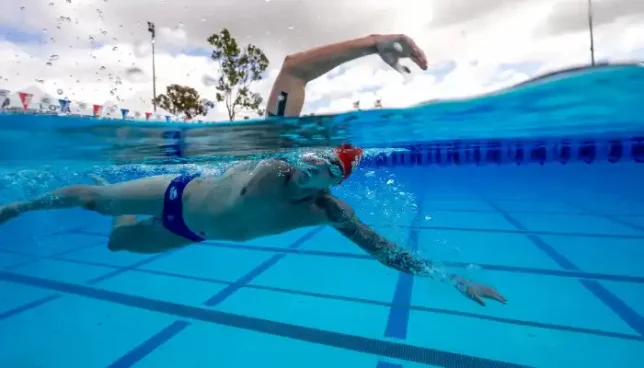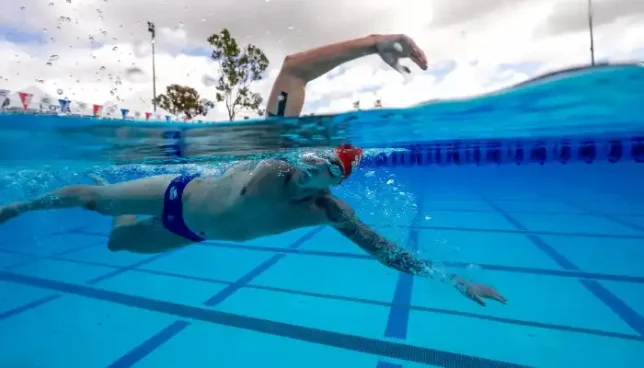Swimming is more than just a sport; it’s a life skill. It opens the door to physical and mental fitness, giving you a low-impact full-body workout that also serves as a peaceful break from everyday life. Whether you’re completely new to swimming or an experienced athlete looking to hone your technique, this guide will give you all the information and resources necessary for navigating through your swimming journey, taking you from someone who watches from the poolside to becoming somebody who can confidently swim anywhere with ease.

Getting Started: Overcoming Fears and Embracing the Basics
Fear of unknown waters is the first obstacle many people face when wanting to learn how to swim. It might be scary not knowing what’s beneath or around us when we can’t see anything clearly due to being surrounded by deep pools, but here’s what most people don’t realize about swimming: fear comes from a lack of experience. This article aims to equip readers with the necessary knowledge about this activity, enabling them to conquer their fears and reap its benefits.
Let us start with some basics:
- Strokes Learning: Freestyle (front crawl), backstroke, breaststroke, and butterfly are four main types of swimming strokes, each having its way of moving through water. We will delve into the fundamental mechanical elements of each stroke, laying a solid foundation for future skill development.
- Different Breathing Techniques: Efficient breathing while swimming is very important because it allows an individual to concentrate on his/her strokes as well as prevents tiredness during such exercises, hence making them enjoyable too.
- Necessary Equipment: You might assume that goggles, swim caps, or even fitting swimwear shouldn’t matter when it comes to being comfortable in pools; however, these items greatly contribute to our comfort levels whenever we find ourselves in the water and therefore, we cannot ignore them at any time. There exist various equipment meant for different purposes therefore we will look at them keenly before helping you choose what suits your needs best.
From Novice to Notable: Intermediate Swimmers Skills Development
Once one has mastered those initial steps, there comes a time when they need to polish up their knowledge base further and improve various areas of swimming skills. At this stage, things start getting interesting as follows:
- Refining The Strokes Used: Here, we concentrate more on making each stroke efficient enough for faster speeds while in water. You learn how to streamline your body position so that it cuts through water easily without any resistance or drag brought about by wrong positions taken during such exercises; kick optimization, which entails applying necessary forces from legs into propelling oneself forward through kicking movement, thus averting unnecessary struggles with buoyancy control; smoothness coupled with controlled arm actions, ensuring easy gliding along pools without tiring quickly, among others.
- The Flip Turn Trick: This is one move that can completely change any swimmer’s experience forever because, once perfected, it saves lots of energy while enabling speedier movements from one lap into another. Breakdowns will be provided here, showing you what happens when entering the pool until the push-off point after having made complete turns around 180 degrees.
- Drills Meant To Increase Chances Of Success: As a swimmer, there are times when you might find some areas becoming weaker than others, hence necessitating coming up with exercises designed specifically for such weaknesses so that overall performance could be raised. We shall introduce different types of drills used for building endurance levels needed during races; speed drills meant to boost faster times over specified distances, among many more, which should always form part of every individual’s training program if at all they want to become better swimmers within the shortest time possible.
- Understanding Pacing Techniques: In order not to get tired too soon without finishing well enough towards the end, it’s important that swimmers know how to pace themselves throughout their workouts. This ensures that there is enough energy left to finish strong and avoid unnecessary early burnouts along the way.
Championing Performance: Advanced Tactics and More
Are you ready to test yourself against others, or do you want to become an elite swimmer? This section contains information on advanced strategies and techniques used by champions:
- Improving Strokes and Turning: Learning advanced skills can help you master the butterfly stroke, which many consider the hardest but most rewarding. This stroke, also known as the dolphin kick, involves moving your legs together up and down like a dolphin’s tail.
- Speed and endurance development: To take your practice to the next level, use more complicated swim sets and interval training; this trains the body to move quickly over short distances and maintain effort over longer ones.
- Mental Preparation for Competition: Mental fitness is just as important as physical health when it comes time for racing or other competitive events. This portion of our discussion will cover techniques like controlling pre-race jitters, staying focused throughout races, and finding resilience in difficult situations.
- Other Training Methods and Dryland Workouts: Swimming is not its own thing; there are many benefits from cross-training with activities such as running or weightlifting that can help with overall fitness levels while also supplementing performance improvements made through swimming alone. In addition, dryland exercises that target different muscle groups should strengthen your core even further while making you more efficient on the water.
The Plan of a Champion
Once you’ve moved beyond beginner status, having some structure around what you do becomes very important. Here’s how to create a program that will propel you forward:
- Structured Training: Develop a plan involving frequency, duration, intensity, etc. based on time rather than sporadically going whenever one feels like it.
- Interval Training: This method builds both speed and endurance simultaneously by alternating periods of intense activity with shorter recovery periods.
- Distance Sets: Gradually increasing the distance swum per session leads to improved stamina.
- Drills: Include stroke refinement exercises in your routine to address specific weaknesses.
There are many online resources available with plans already set out depending on skill level, so I would suggest checking those out, but if not, find someone knowledgeable about swimming who could design something specifically for you.
- Goal Setting: Having clear objectives keeps things interesting and provides focus. Is there a particular distance goal? I would love to do triathlons eventually. This will help shape the training plan and track progress.
Thriving Through Challenges: Battling Setbacks and Plateaus
Achieving top-level performance does not come easy or without its fair share of obstacles. Here’s how to navigate those setbacks and keep pushing forward:
- Dealing with Setbacks: Injuries happen; when they do, prioritize rest to fully recover.
- Rest and Recovery: Allow enough time for recovery during intense periods or hard workouts. Sleep is the best time for muscle repair, so make sure you get quality sleep every night.
- Overcoming Plateaus: Hitting a wall in training is demoralizing, but don’t be afraid to change things up! Try different drills, go swim open water vs pool, or even seek coaching input—all can help push through stagnation points.
- Staying Motivated: There will be days when it doesn’t feel like going, but this should never outweigh the desire to succeed at the sport. Find other swimmers with similar goals, join clubs together, or use a coach to hold you accountable, etc.
Mind Over Matter: Embracing Mental Toughness
Physical fitness only takes one so far; developing mental attributes is also a key part of becoming a successful competitive swimmer:
- Mental Resilience and Focus Develop the ability to bounce back from setbacks and stay focused during particularly grueling periods of training or racing. Some methods include meditation exercises alongside visualization techniques, which build mental toughness.
- Visualization: Picture yourself achieving every objective. Additionally, practice your races in your mind’s eye and see yourself making perfect strokes that lead you to the desired outcome. This helps you to be sure about what you want and build faith.
- Pre-Competition Jitters: Anxiety before a game is normal, even for an experienced athlete. Apply healthy approaches like deep breaths or soft music, which will calm you down, thus enabling you to use this energy to concentrate on winning.
- Celebrating Achievements and Humility: Give credit where it’s due; recognize all achievements made during this period, whether they were great or small; Letting pride get into us will not do any good, so let’s remain modest about our successes while still aiming for higher heights, always learning from others who swim better than us as we walk this journey whose end cannot be seen till forever.
Conclusion
This manual offers comprehensive guidance on swimming, from relaxing poolside strolls to applying competitive finishing touches. Remember, becoming a winner takes time; therefore, never stop loving those moments when everything feels right within reach as well as beyond it (gliding through water). Well, then take that leap forward into unknown territories, with swimming being no exception, sharing discoveries along the way among our peers who share similar interests where betterment remains possible.

